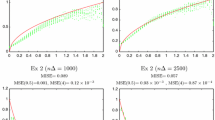Abstract
Two-step methods are suggested for obtaining optimal performance in the problem of estimating jump points in smooth curves. The first step is based on a kernel-type diagnostic, and the second on local least-squares. In the case of a sample of size n the exact convergence rate is n − 1, rather than n − 1 + δ (for some δ > 0) in the context of recent one-step methods based purely on kernels, or n − 1 (log n)1 + δ for recent techniques based on wavelets. Relatively mild assumptions are required of the error distribution. Under more stringent conditions the kernel-based step in our algorithm may be used by itself to produce an estimator with exact convergence rate n − 1 (log n)1/2. Our techniques also enjoy good numerical performance, even in complex settings, and so offer a viable practical alternative to existing techniques, as well as providing theoretical optimality.
Similar content being viewed by others
REFERENCES
Carlstein, E., Müller, H.-G. and Siegmund, D. (1994). Change-Point Problems, Institute of Mathematical Statistics Lecture Note Series Vol. 23, Hayward, California.
Eubank, R. L. and Speckman, P. L. (1993). Confidence bands in nonparametric regression, J. Amer. Statist. Assoc., 88, 1287–1301.
Eubank, R. L. and Speckman, P. L. (1994). Nonparametric estimation of functions with jump discontinuities, Change-Point Problems (eds. E. Carlstein, H.-G. Müller and D. Siegmund), Institute of Mathematical Statistics Lecture Note Series Vol. 23, 130–144, Hayward, California.
Hall, P. and Titterington, D. M. (1992). Edge-preserving and peak-preserving smoothing. Technometrics, 34, 429–440.
Korostelev, A. P. (1987). On minimax estimation of a discontinuous signal, Theory Probab. Appl., 32, 727–730.
Korostelev, A. P. and Tsybakov, A. B. (1993). Minimax Theory of Image Reconstruction, Lecture Notes in Statistics Vol. 82, Springer, Berlin.
Loader, C. L. (1997). Change-point estimation using nonparametric regression, Ann. Statist., 24, 1667–1678.
Mcdonald, J. A. and Owen, A. B. (1986). Smoothing with split linear fits, Technometrics, 28, 195–208.
Marcus, M. B. (1970). A bound for the distribution of the maximum of continuous Gaussian processes, Ann. Math. Statist., 41, 305–309.
Müller, H.-G. (1992). Change-points in nonparametric regression analysis, Ann. Statist., 20, 737–761.
Müller, H.-G. and Song, K.-S. (1997). Two-stage change-point estimators in smooth regression models, Statist. Probab. Lett., 34, 323–335.
Raimondo, M. (1996). Modeles en rupture, situations non ergodique et utilisation de méthode d'Ondelette, Ph.D. Thesis, University of Paris VII.
Seifert, B. and Gasser, T. (1996). Finite-sample analysis of local polynomials: analysis and solutions, J. Amer. Statist. Assoc., 91, 267–275.
Shorack, G. R. and Wellner, J. A. (1986). Empirical Processes with Applications to Statistics, Wiley, New York.
Wang, Y. (1995). Jump and sharp cusp detection by wavelets, Biometrika, 82, 385–397.
Wu, J. S. and Chu, C. K. (1993). Kernel type estimators of jump points and values of a regression function, Ann. Statist., 21, 1545–1566.
Author information
Authors and Affiliations
About this article
Cite this article
Gijbels, I., Hall, P. & Kneip, A. On the Estimation of Jump Points in Smooth Curves. Annals of the Institute of Statistical Mathematics 51, 231–251 (1999). https://doi.org/10.1023/A:1003802007064
Issue Date:
DOI: https://doi.org/10.1023/A:1003802007064




